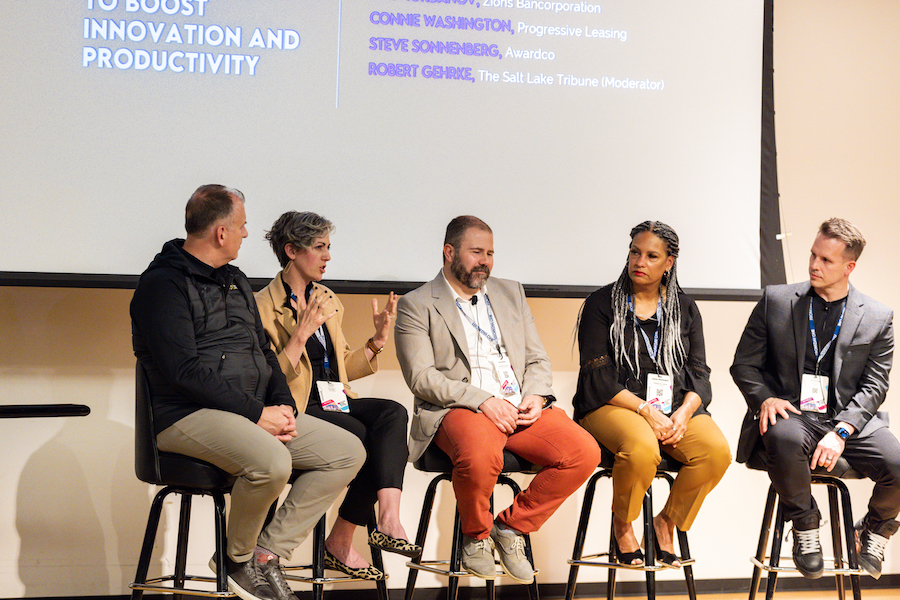Stimulating a Culture of Healthy Feedback to Boost Innovation and Productivity


Achieving a culture of feedback demands first instilling a culture of safety. That was the consensus of a panel discussion at From Day One’s live conference in Salt Lake City, where five expert panelists offered advice backed by stories demonstrating both what to do and what not to do when helping employees feel safe while providing feedback. The conversation was moderated by Robert Gehrke, government and politics reporter at the Salt Lake Tribune.
Connie Washington, VP of people at Progressive Leasing, made the case for a culture of safety by defining the manifold benefits of getting it right.
“When somebody feels like they belong and they're safe, you get higher engagement, you get better performance, you get better retention,” Washington said. “And so that psychological safety is huge, that ‘I can make a mistake, I can do something wrong, and it's not the end of the world.’”
Washington feels that a true culture of safety should be 360 degrees, in that employees should feel safe both giving and receiving challenging feedback.
“One of my employees, when I would give her feedback, would go into a death spiral if it wasn't positive,” Washington recounted. “So I figured out a way to converse with her. During a one-on-one I said, ‘listen, here's my vision for you and where I see you being, but for you to get there, you're going to need feedback. And so I'm going to ask your permission to give you feedback. And that'll be the cue that we're going to talk about something.’ And it really changed the dynamic, because she wasn't blindsided by it. And she knew that my goal was for her to continue to grow and to get to the next level where she wanted to be.”

Washington adds that a culture of safety must begin at the top of the organization.
“At a previous company, the CEO would host employee lunches and say, ‘tell me, whatever, this is open, let's talk.’ And so one person was like, ‘well, then let's talk. Do you have any idea what is happening and such and such?’ There were 50 people in the room and it made everybody uncomfortable and she walked out crying, and the CEO wanted her fired,” Washington recalled. “Creating that sense of safety, it’s important that people are comfortable and not crying when they walk out of an interaction with the CEO.”
Whitney Harper, SVP of people at ExtraSpace Storage, finds that employees will open up in meaningful ways when they are encouraged to go deeper in their feedback sessions.
“Sometimes, by asking ‘what else?’ you get to the next layer down, and you're kind of role modeling like, ‘this is safe, I want to hear everything that you have to tell me,” Harper said. “You have to role model it regularly. If you don’t receive feedback each week, it's been too long. Just ask your team members what you can do to help them make their jobs easier. Role modeling that behavior creates that culture of safety.”
Acquiring measurable data is good, but quarterly or annual employee surveys are not the best way to get meaningful feedback, according to Ivan Iordanov, VP of enterprise learning and development at Zions Bancorp.
“Surveys are the wrong questions at the wrong time for the wrong reason. You’re less likely to hear positive feedback. Or you may just hear generic feedback. Companies need to develop something more organic that’s able to capture the data but not just as part of a survey,” Iordanov said. “One-on-ones and coaching [sessions] are when employees tend to open up, especially when the person they talk to shows empathy and support and it's safe, and there's no fear of retaliation, particularly if the employees want to remain anonymous. If you want to collect survey data, do a survey afterwards. You will be more successful.”
Helping employees feel both safe and valued can be as easy as adding a few minutes to company meetings, according to Head of People at Overstock, Carter Lee.
“We have a culture document, listing our values and our leadership principles. We like to bring examples of employees living those leadership principles to the surface. And so we start most of our meetings with an example of it,” Lee said. “And I think that creates a safe zone, because you're not only saying these things, but you're highlighting people that do those things in your organization and when employees are saying good things about each other, when we challenge ideas and not people, they're more likely to give feedback all the time.”
Steve Sonnenberg is the founder and CEO of the employee recognition firm, Awardco. Understandably, he feels that helping employees feel appreciated is key to building a culture of safety in an organization.
“You need to develop a culture of appreciation, to then create that safe environment where people feel a sense of belonging,” Sonnenberg said. “When they feel they belong and are appreciated, they’re going to feel that their feedback is also valued.”
Sonnenberg went on to effectively frame the value that feedback offers an organization.
“It's extremely important to take feedback, process what you learned, and recognize that individual for giving it to you,” Sonnenberg added. “Feedback is a gift. And if it's not received or appreciated as a gift, you might not get it again.”
Judd Bagley is a Utah-based marketing communications professional and freelance journalist.
The From Day One Newsletter is a monthly roundup of articles, features, and editorials on innovative ways for companies to forge stronger relationships with their employees, customers, and communities.